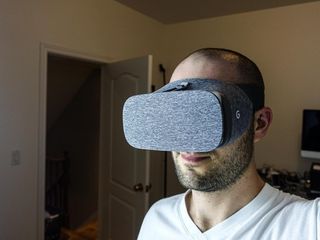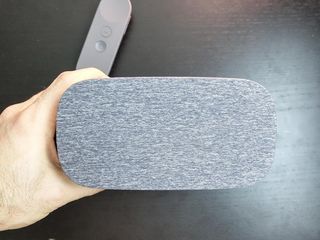Using the smaller Pixel with Google Daydream is a big compromise

It's not looking good for Pixel owners who want to use Google's new Daydream View VR headset. The phone's 1080p resolution AMOLED display is good enough for daily use when held at a nominal distance from one's face, but strapped into a VR headset, the individual pixels are not only visible but distracting, and our advice is to avoid using the smaller Pixel for mobile VR.
The resolution

Let's talk about the resolution. I spent a lot of time going between the Pixel and Pixel XL in the Daydream View, and the higher density on the latter phone's QHD display — 534ppi to the Pixel's 440ppi — is not only obvious but essential to the enjoyment of the experience. I found myself often distracted, even in the midst of a video or game, by the individual components comprising the whole. And while those components are still somewhat noticeable on the larger Pixel XL, we've learned by now that the more we can minimize distraction while in virtual reality, the more immersive and enjoyable the experience.
I still enjoyed the Pixel in the Daydream View, and unless you've used a Gear VR with Galaxy S7 or something with an equally high density you may not be disappointed, but I have, and it was.
The field of view

The other thing to keep in mind about using the smaller Pixel is that its physically smaller screen makes the field-of-view ever-so-slightly narrower, lessening by a few millimeters the amount of space you can see in virtual reality. In, ahem, reality, it's not that big a deal, and you're unlikely to notice it unless, as above, you're coming from the Pixel XL, but keep these things in mind.
Light bleed


This is a problem for both Pixels, but the smaller unit does let in noticeably more light than the larger one. It's not necessarily the bottom area that leeches in additional light, but the overall surface area of the phone being smaller that, in a well-lit room, makes the experience slightly more distracting.
That's easily avoided by lowering the ambient light around you — turn off the bulbs, lower the blinds, close the curtains — but if you're in an environment like an airplane where you can't control these things, the Pixel XL is a superior choice.
Battery life and heat

The Pixel XL does have a larger battery than the Pixel, but due to its extra resolution doesn't necessarily achieve additional uptime. I typically got three to four hours of constant use from each unit, which is pretty darn impressive for a mobile VR suite, and unlike the Gear VR, the phone's charging port is open while lodged in the Daydream View. It's likely that future Daydream headset designs will also be required to allow for concurrent charging, too.
Be an expert in 5 minutes
Get the latest news from Android Central, your trusted companion in the world of Android
Both phones get very hot while inside the View, but it did seem that the smaller Pixel was slightly warmer to the touch. I don't have a thermometer to register the absolute difference between the two, but I'd say that the Pixel was some five to 10 degrees Fahrenheit toastier than the XL.
Other considerations

Obviously, the Pixel XL is a sizeable jump in price from the Pixel — $120 USD, and more in some markets. That, plus the $79 for the Daydream View itself, is no small price to pay. If it comes down to using the combination of a Pixel and Daydream together, or nothing at all, of course I'd choose the former: the experience is amazing regardless of which Pixel you're using, and Google has done an amazing job ensuring that either model works seamlessly within the View headset.
There's also the question of color: is it better to use a black or white Pixel with the Daydream View? I got a chance to use both colors and found little difference between them; the rumored additional reflectiveness of the white phone face did not manifest itself in real-world use, especially when the ambient light was low.
At the end of the day, Daydream and its first headset, Daydream View, are remarkable achievements, and must be tried even if you're familiar with the Gear VR, Cardboard or any other mobile VR solution. Daydream is fun; it is effortless; it is flawed, in a good way. I love it. Even with the Pixel, which is distraction central.
Daniel Bader was a former Android Central Editor-in-Chief and Executive Editor for iMore and Windows Central.

